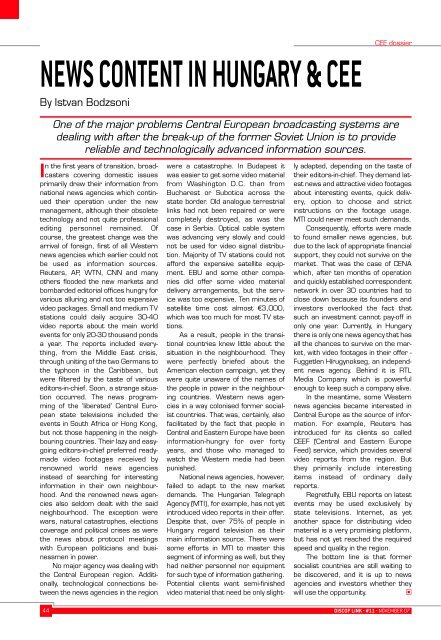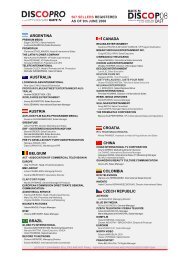discop link • #11
discop link • #11
discop link • #11
- No tags were found...
You also want an ePaper? Increase the reach of your titles
YUMPU automatically turns print PDFs into web optimized ePapers that Google loves.
CEE dossierNEWS CONTENT IN HUNGARY & CEEBy Istvan BodzsoniOne of the major problems Central European broadcasting systems aredealing with after the break-up of the former Soviet Union is to providereliable and technologically advanced information sources.In the first years of transition, broadcasterscovering domestic issuesprimarily drew their information fromnational news agencies which continuedtheir operation under the newmanagement, although their obsoletetechnology and not quite professionalediting personnel remained. Ofcourse, the greatest change was thearrival of foreign, first of all Westernnews agencies which earlier could notbe used as information sources.Reuters, AP, WTN, CNN and manyothers flooded the new markets andbombarded editorial offices hungry forvarious alluring and not too expensivevideo packages. Small and medium TVstations could daily acquire 30-40video reports about the main worldevents for only 20-30 thousand pondsa year. The reports included everything,from the Middle East crisis,through uniting of the two Germans tothe typhoon in the Caribbean, butwere filtered by the taste of variouseditors-in-chief. Soon, a strange situationoccurred. The news programmingof the 'liberated' Central Europeanstate televisions included theevents in South Africa or Hong Kong,but not those happening in the neighbouringcountries. Their lazy and easygoingeditors-in-chief preferred readymadevideo footages received byrenowned world news agenciesinstead of searching for interestinginformation in their own neighbourhood.And the renowned news agenciesalso seldom dealt with the saidneighbourhood. The exception werewars, natural catastrophes, electionscoverage and political crises as werethe news about protocol meetingswith European politicians and businessmenin power.No major agency was dealing withthe Central European region. Additionally,technological connections betweenthe news agencies in the regionwere a catastrophe. In Budapest itwas easier to get some video materialfrom Washington D.C. than fromBucharest or Subotica across thestate border. Old analogue terrestrial<strong>link</strong>s had not been repaired or werecompletely destroyed, as was thecase in Serbia. Optical cable systemwas advancing very slowly and couldnot be used for video signal distribution.Majority of TV stations could notafford the expensive satellite equipment.EBU and some other companiesdid offer some video materialdelivery arrangements, but the servicewas too expensive. Ten minutes ofsatellite time cost almost €3,000,which was too much for most TV stations.As a result, people in the transitionalcountries knew little about thesituation in the neighbourhood. Theywere perfectly briefed about theAmerican election campaign, yet theywere quite unaware of the names ofthe people in power in the neighbouringcountries. Western news agenciesin a way colonised former socialistcountries. That was, certainly, alsofacilitated by the fact that people inCentral and Eastern Europe have beeninformation-hungry for over fortyyears, and those who managed towatch the Western media had beenpunished.National news agencies, however,failed to adapt to the new marketdemands. The Hungarian TelegraphAgency (MTI), for example, has not yetintroduced video reports in their offer.Despite that, over 75% of people inHungary regard television as theirmain information source. There weresome efforts in MTI to master thissegment of informing as well, but theyhad neither personnel nor equipmentfor such type of information gathering.Potential clients want semi-finishedvideo material that need be only slightlyadapted, depending on the taste oftheir editors-in-chief. They demand latestnews and attractive video footagesabout interesting events, quick delivery,option to choose and strictinstructions on the footage usage.MTI could never meet such demands.Consequently, efforts were madeto found smaller news agencies, butdue to the lack of appropriate financialsupport, they could not survive on themarket. That was the case of CENAwhich, after ten months of operationand quickly established correspondentnetwork in over 30 countries had toclose down because its founders andinvestors overlooked the fact thatsuch an investment cannot pay-off inonly one year. Currently, in Hungarythere is only one news agency that hasall the chances to survive on the market,with video footages in their offer -Fuggetlen Hírugynokseg, an independentnews agency. Behind it is RTLMedia Company which is powerfulenough to keep such a company alive.In the meantime, some Westernnews agencies became interested inCentral Europe as the source of information.For example, Reuters hasintroduced for its clients so calledCEEF (Central and Eastern EuropeFeed) service, which provides severalvideo reports from the region. Butthey primarily include interestingitems instead of ordinary dailyreports.Regretfully, EBU reports on latestevents may be used exclusively bystate televisions. Internet, as yetanother space for distributing videomaterial is a very promising platform,but has not yet reached the requiredspeed and quality in the region.The bottom line is that formersocialist countries are still waiting tobe discovered, and it is up to newsagencies and investors whether theywill use the opportunity. }44 DISCOP LINK <strong>•</strong> <strong>#11</strong> <strong>•</strong> NOVEMBER 07
















